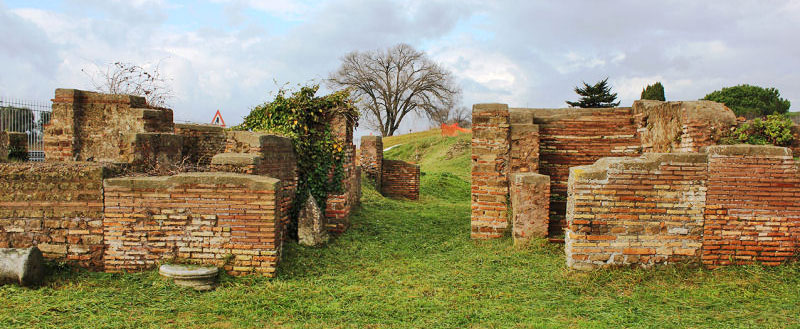
In 2018 there has been another excavation campaign in the area outside the Porta Marina in Ostia Antica. This year the emphasis was on further examination of the Caseggiato delle due Scale and an area next to the Mitreum with the Coloured Marbles. We had three interviews with archaeologists from the staff, who worked in this campaign under the direction of professor Massimiliano David.
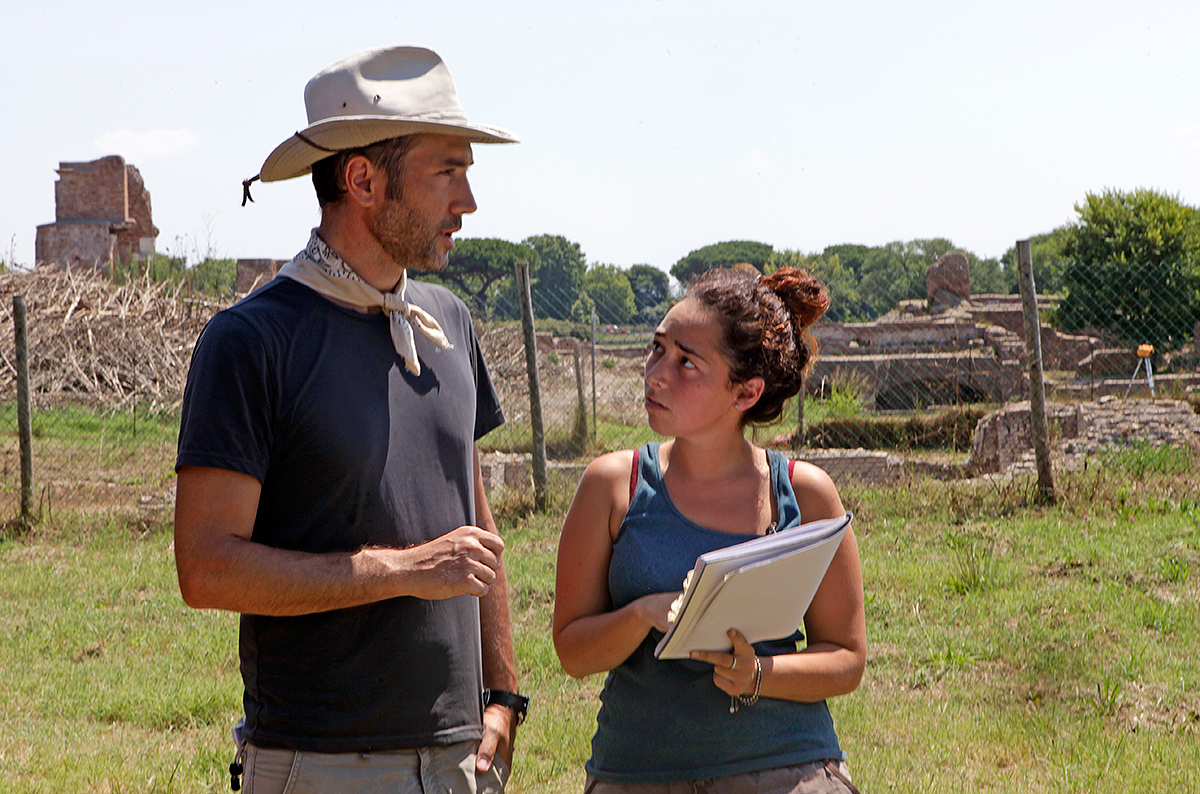
STEFANO DE TOGNI
Coordinator and technical scientific director on the site.
Question: How many years does this project exist already?
Stefano: “This is the twelfth excavation season. The first was in 2007. We started exploring the site followed by a series of geophysical tests with a magnetometer and ground radar. This led in 2008 to the first stratigraphic test of the excavation area which, from that year on, is running each year again."
Question: What did you find in those years?
Stefano: "First we brought to light the so-called Terme del Sileno (the Baths of Silenus). These baths occupy the central western part of room IX. Then we discovered completely the Caseggiato delle Due Scale (the Building with the Two Staircases) that we originally named Caseggiato lungo la Via della Marciana (the Building alongside the Street of Marciana). So this is a part of the new city quarter outside the Porta Marina uncovered by the Ostia Marina project during the first years."
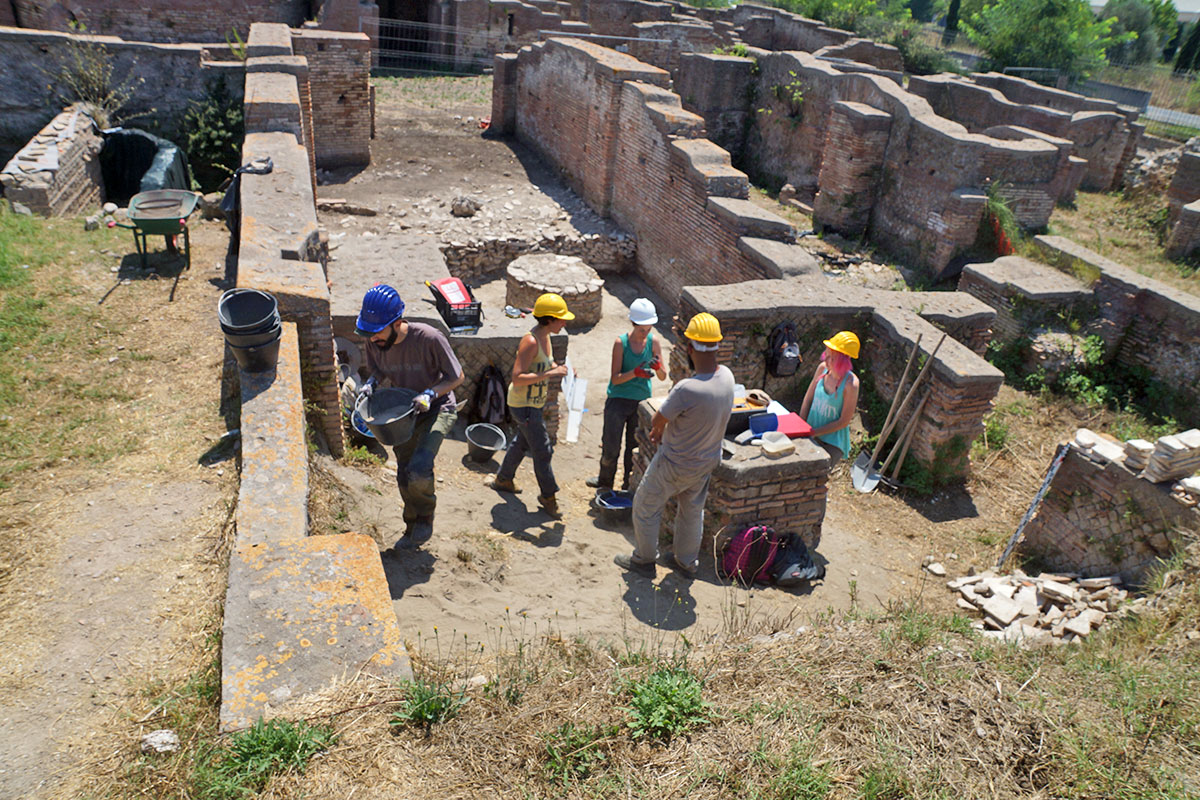
Behind room 2 we see shop 3.
Question: What did you discover in the following years?
Stefano:: "In 2014 we excavated, immediately north of the Caseggiato delle Due Scale, the Caupona del dio Pan (the Bar of the god Pan) 2. The southern façade of both the Caupona and the Caseggiato delle due Scale form one large facade along the Via della Marciana.”
Question: Do you have a specific goal this year?
Stefano: "This year, during the twelfth campaign, we are engaged in the excavation of a particular space in the Caseggiato delle Due Scale, room 3, a shop with a view on the Via della Marciana. In this accommodation, directly south of the Caupona del Dio Pan, we have found a series of floor elevations that allows us to determine the chronology of the occupation of this area exactly, especially for the earlier phases of habitation."
Question: With how many people are you working this year?
Stefano: “This year we’re working with 25 persons. Five members of the staff and twenty students. Most of them are students from the University of Bologna.”
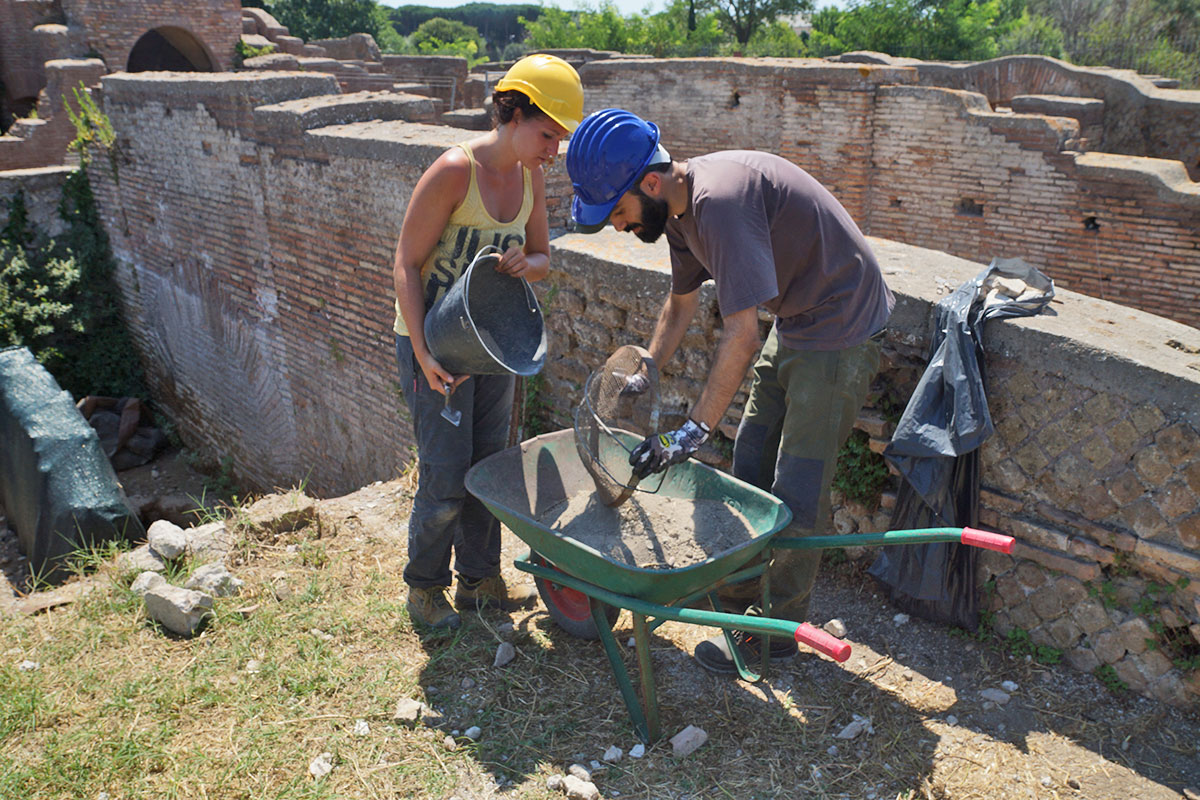
Question: At the end of the previous campaign everything was covered up. How long does it take before the site is re-opened again and further research can start?
Stefano:"That is a fairly precise operation but we can do it quickly. For this job, we have developed a special system. Already on the first day we start with opening up the archaeological surfaces that came to light the year before. These were covered with special protective cloths. First we remove the cover above the surfaces we wish to work on and then we start. The cover will only be removed one time in its entirety, but then permanently, when the whole project is ready."
CAMILLA ROSATI
Member of the staff – materials
Question: Camilla, what’s the art of your work?
Camilla: “I’m responsible for the materials coming here straight away from the excavation. The materials will be washed, cleaned and inventoried. Together with the students I check the boxes with finds.”
Question: What kind of material has been found in general?
Camilla:"Here in Ostia that can be all possible materials well known from the Roman period and late classical time. The most common are ceramics, bricks, metals such as iron, bronze and lead. But also material of stone and coloured stucco plaster. In addition to archaeological finds there are anthropological and vegetable objects as well.”
Question: What happens with the material coming here from the site?
Camilla:"The material that comes in is first ordered. After that, it is washed by the students. If the material is cleaned with a dry brush, a part will be divided in main and subcategories. Then we put together lists of the contents of the boxes. Then these boxes with the finds go to new depots to be studied."
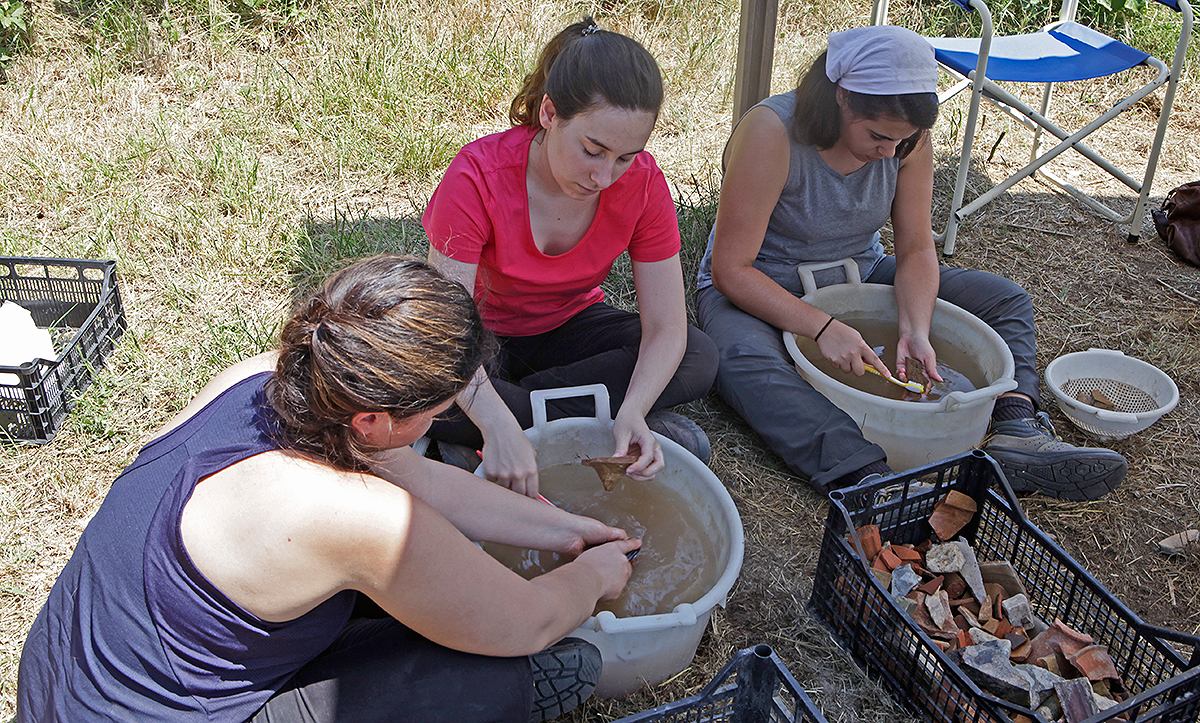
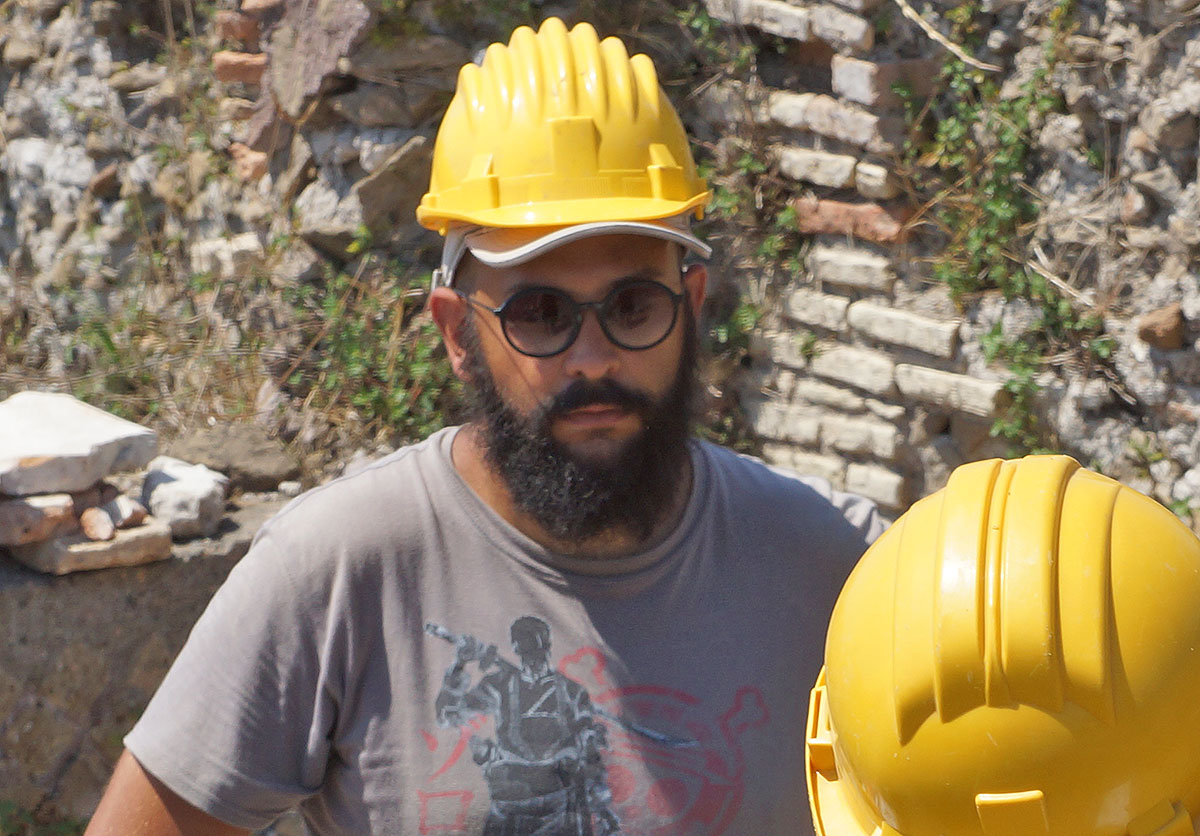
DINO LOMBARDO
Technical scientific staff member of the Ostia Marina Project.
Question: Dino, how many years have you been working for the Ostia Marina Project?
Dino: “I work here already eight years. It’s the eighth year I excavate under the direction of Professor Massimiliano David 3."
Question: Do you like this project and if yes, why?
Dino: “Yes, I like it very much because we succeed in studying the last phase of this offshoot of the city of Ostia. On that last phase in relation to the rest of the city especially we know very little. I have to say that my interests are focused on Late Antiquity and in particular on Christian Antiquity.”
Question: Stefano told me that this year there will be worked specially on room 3 of the Caseggiato delle Due Scale?
Dino: “We decided this because this space is the only one we haven’t excavated and surveyed deeply, but only superficially. Now we examine the layers related to the phases of the late medieval looting.”
Question: How far are you at this moment?
Dino: "The work is about halfway and so is the campaign. At this moment we are mainly engaged in phases of the modern looting, a theme little treated in Ostia. There are clear traces of that looting visible. Besides that, we also have studied the layers related to the first phase of life of this caseggiato, which can be dated to the time of Hadrian.”
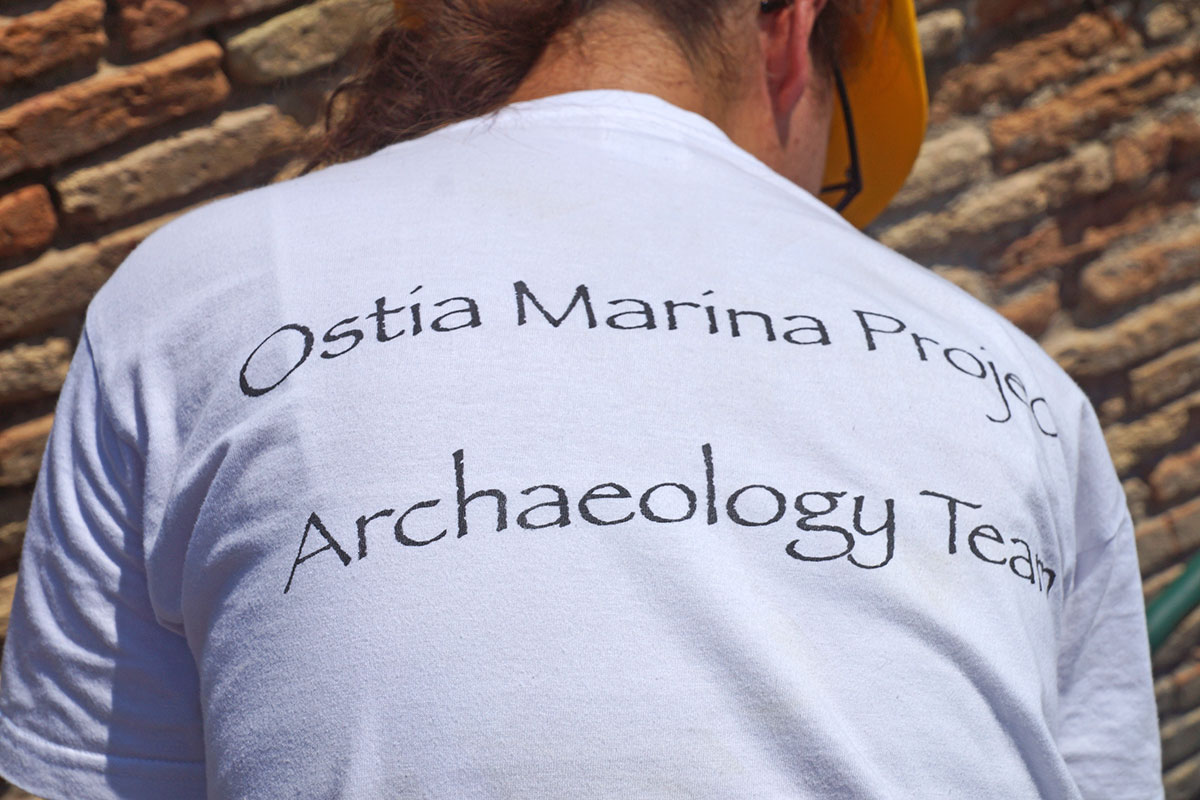
THE CASEGGIATO DELLE DUE SCALE - A report by Stefano de Togni

The eastern area of block IX in region IV of Ostia was first explored during ground work in the context of the construction of E42 4. In 1971, during excavations focused on the restoration of the already discovered walls, the area was further excavated. The east side of space IX was then taken up by a caseggiato (building block) along the Via della Marciana, the street that forms the eastern border (photo 7). Recent investigations in the framework of the Ostia Marina Project have shown that it was actually not one but two separate buildings. The southern building got the name of Caseggiato delle Due Scale (Building with the Two Staircases), because of the special layout on the ground floor. The northern building was called the Caupona del Dio Pan. The Building with the Two Staircases is a large building in which you can see well different parts of the floor plan and parts of the later layers, which at various points on the oldest floor have been preserved.
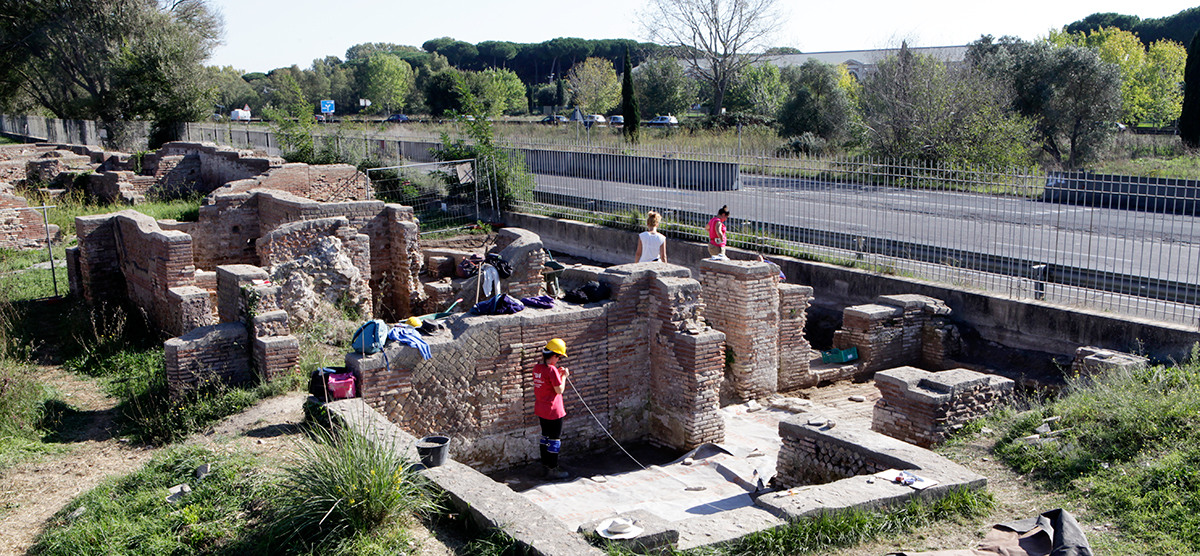
The western wall is not directly in contact with the Terme del Sileno but is separated by a three-metre-wide lane. The southern border, now provided by the fence of the archaeological park, must have been determined originally by the course of the road along the coast. The total space that is taken up amounts to about 1000 square meters. Originally the building had a patio on the north side, on which, in the middle of the third century, the Caupona del Dio Pan was built.
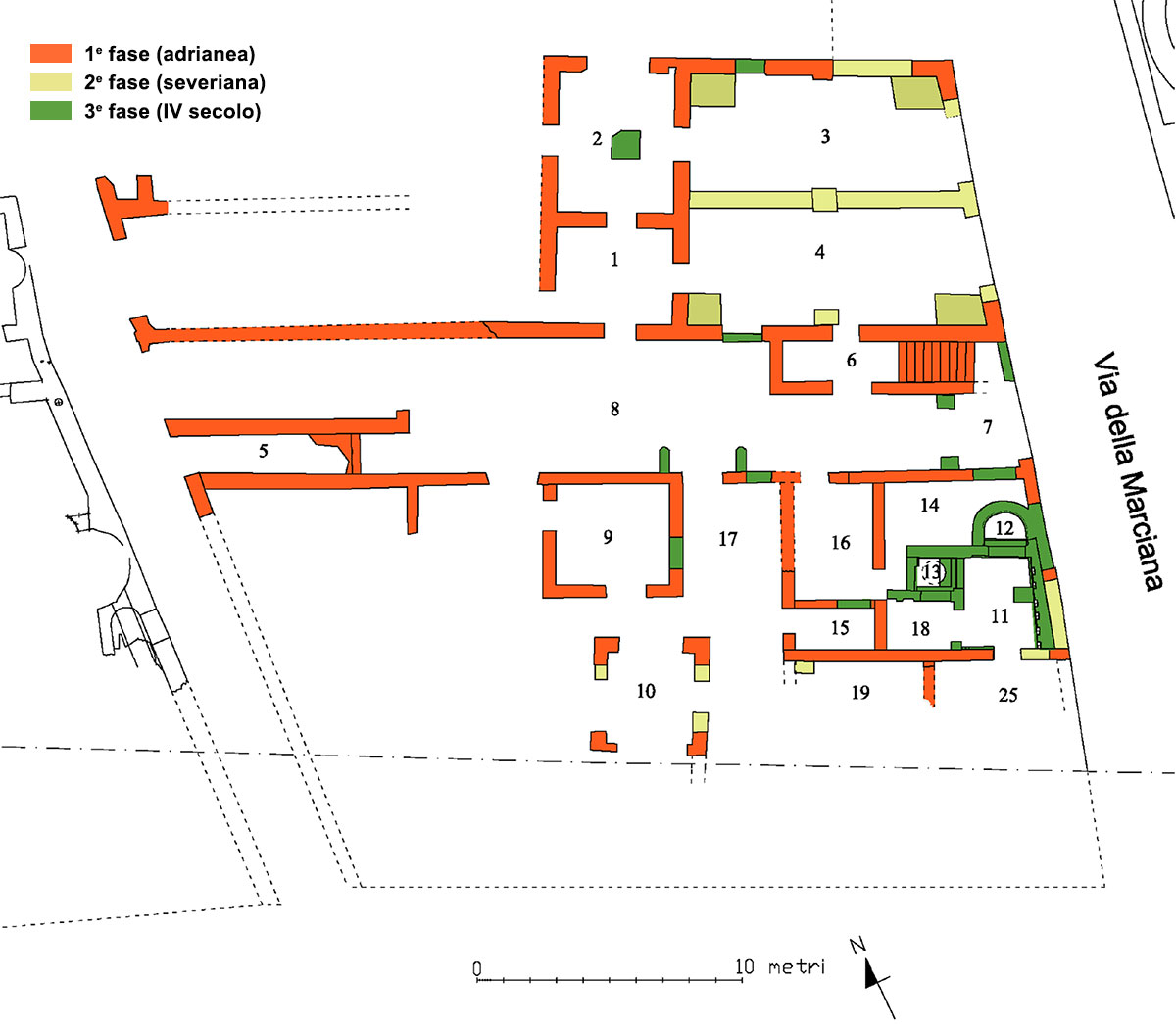
Phase 1: The building at the time of Hadrianus (first half of second century AD)
The first building phase of the caseggiato was carried out almost entirely in opus reticolatum mixtum 5. In the two-foot projections of space 1 and 2 three brickstamps dating to the third consulate of Servianus 6 (134 AD) have been found. In this phase, the building was constructed with at least two floors. The special format shows a broad central corridor (space 8) with two entrances opposite each other, whereby people could reach the upper floor through two symmetrical staircases (spaces 5 and 6).
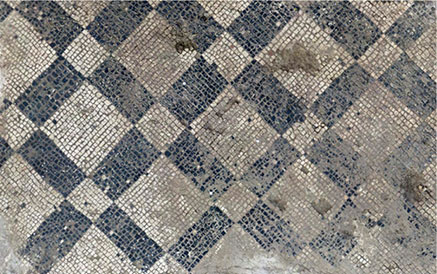
time of Hadrian.
One of the two spaces, number 5, includes a floor in opus spicatum 7. The central part of area 8 should have been covered. The part on the north side of the corridor was formed by two square inner spaces (spaces 1 and 2) equipped with a black and white mosaic floor of which some fragments have been preserved. Especially in these rooms you could see well how the subfloors were constructed. They mainly consisted of layers of discarded painted and scratched stucco that probably was used to protect the floor from the high humidity due to the proximity of the sea 8. The paintings on the decorated stucco were from the end of the first century AD. The layout on the south side is difficult to interpret, partly because little of this side has been preserved. Room number 10 may have been another open air space, perhaps with a small impluvium 9. The building was probably meant for both residential and commercial purposes and is similar, for example, to the Caseggiato dei Dipinti in Ostia.
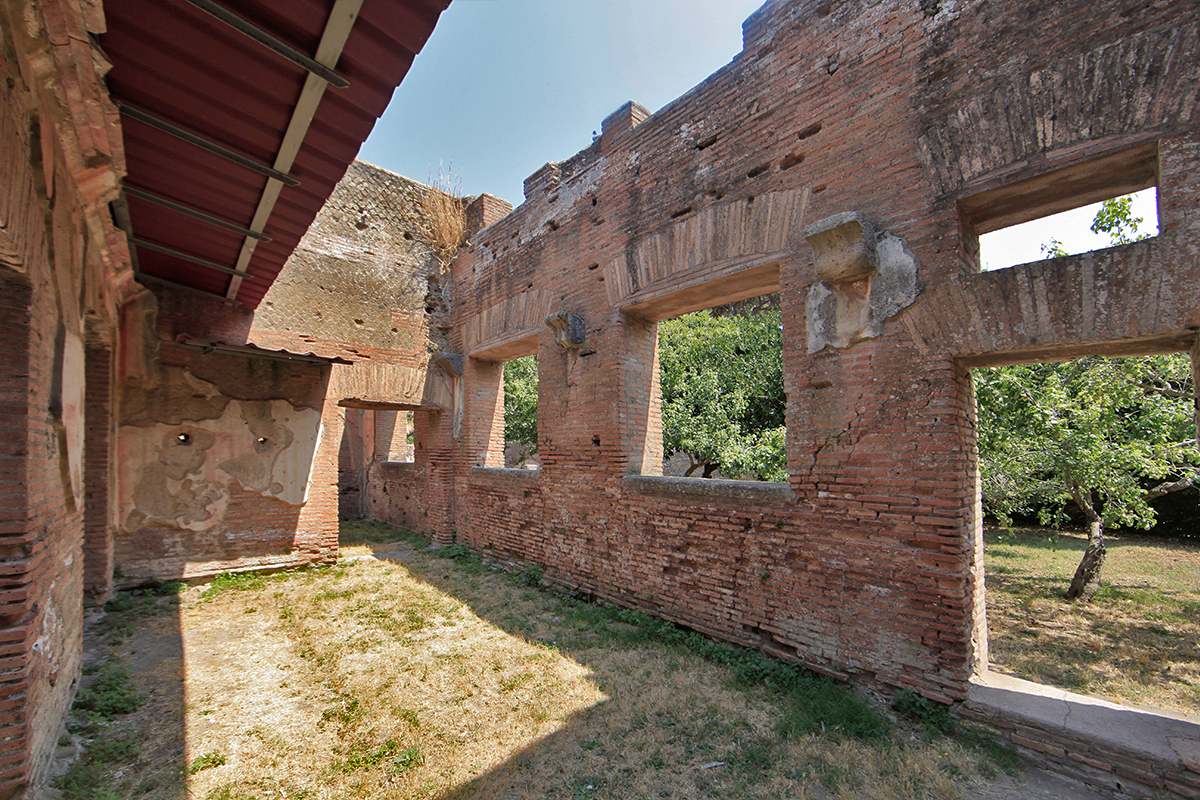
Phase 2: The shops
The large quadrangular space overlooking the Via della Marciana is divided into two smaller rooms by a wall in opus testaceum (brick). The two elongated compartments (spaces 3 and 4) can be interpreted as shops, the spaces 1 and 2 on the other hand as areas behind the shop. On the basis of the brickstamps found here it is possible to date this phase before the beginning of the third century.
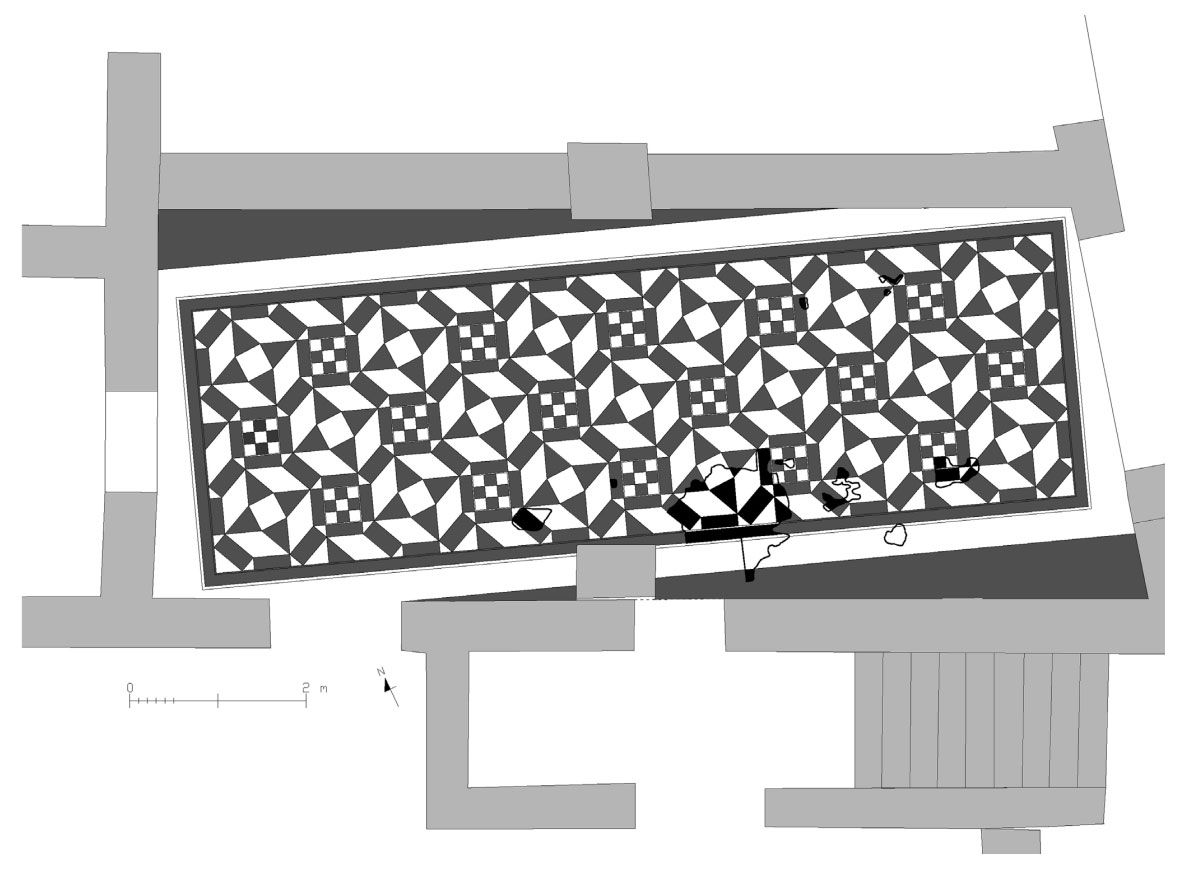
In Shop 4 various pieces of a black and white mosaic floor, which certainly belongs to this building phase, have been preserved. The mosaic is better preserved on the south side of the room. It consists of a geometric mosaic characterized by octagons of which the majority is regular, a small part irregular, and by rectangles. The special place of the mosaic suggests that it was meant to impress the customers entering the shop from the Via della Marciana.
Phase 3: The workshops and the Terme dello Scheletro.
In the fourth century the building underwent a series of reorganizations. In the middle of room 2 a square, brick pillar was constructed, probably to strengthen the building. The quadrangular space that overlooked the Via della Marciana in the south wing and the areas south and west of this space are interesting because of the construction of small baths, the so-called Terme dello Scheletro (the Baths of the Skeleton).

In the shops (areas 1, 2, 4) evidence has been found of a reorganization showing a new exploitation of the space for the benefit of artisans and commerce, perhaps related to metalworkers. The ground floor in all three areas is characterized by progressive raised levels, which formed three consecutive levels of beaten earth. Each of these levels contained an extreme amount of scattered coins to a total of 696 pieces. The chronology of the coins allows us to date this phase to the end of the fourth and the beginning of the fifth century AD.

- Notes
- 1: Photo: Stefano de Togni 2014.
- 2: See our article 'The last excavated Mithras sanctuary'.
- 3: Professor Massimiliano David is scientific director of the Ostia Marina Project.
- 4: E42: Esposizione Universale di Roma (EUR), or the world exhibition of 1942 in Rome. Due to World War II the exhibition was cancelled. The great excavation campaign at Ostia by Guido Calza had to be an important part of that exhibition.
- 5: Opus mixtum: construction technique in which small, square stones of tuff are alternated with brick.
- 6: Lucius Iulius Ursus Servianus (45-136), Roman consul.
- 7: Opus spicatum is a floor covering of terracotta pieces in a fishbone pattern.
- 8: Probably the material came from neighbouring buildings demolished during the renewing of the city in the time of Hadrian.
- 9: A rectangular reservoir in the floor, collecting rainwater.
- 10: Photo: David - De Togni.
- -Photos 2, 3, 4 and 6 : Anne Mara Muijsson-Tideman.
- -Graphics: Stefano de Togni.






 We are committed to providing versions of our articles and interviews in several languages, but our first language is English.
We are committed to providing versions of our articles and interviews in several languages, but our first language is English.